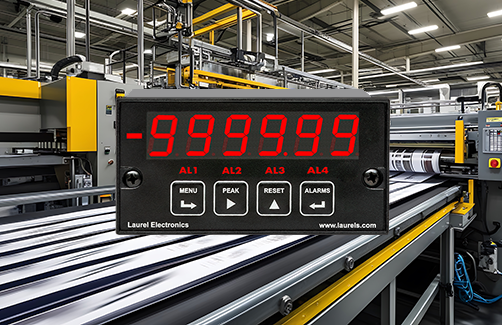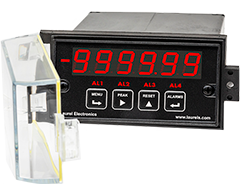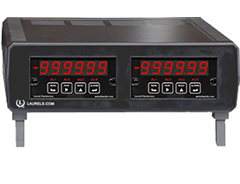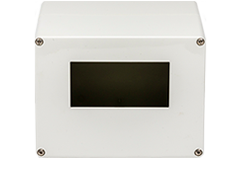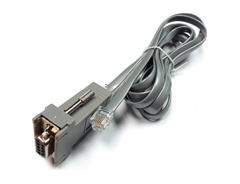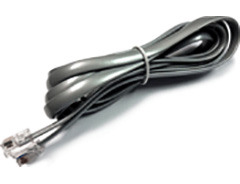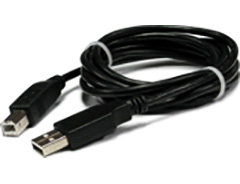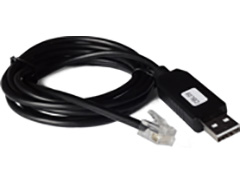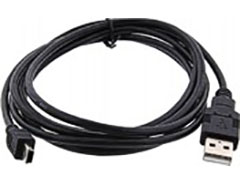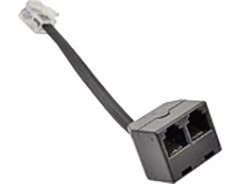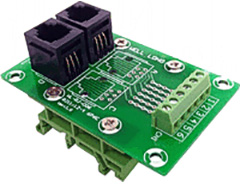Features
- Two independently scalable totals for Channels A & B
- Arithmetic functions A+B, A-B, AxB, A/B, A/B-1 applied to rate or total
- Inputs from NPN or PNP proximity switches, contact closures, digital logic, magnetic pickups down to 12 mV, or AC inputs up to 250 Vac
- Frequencies from 0.005 Hz to 1 MHz
- Digital span adjust from 0 to ±999,999, zero adjust from -999,999 to +999,999
- Front panel scalable to ±999,999 for use with current shunts
- 1/8 DIN size with bright red or green 0.56" (14.2mm), high LED digits
- Transducer excitation output, 5, 10, 12, or 24 Vdc (isolated)
- Power 85-264 Vac / 90-300 Vdc or 10-48 Vdc / 12-32 Vac (isolated)
- Operating temperature from -40°C to 70°C (-40°F to 158°F)
- Wide choice of Plug-in-Play options:
- 2 or 4 relays, mechanical or solid state, for alarm or control (isolated)
- 1 or 2 Analog output, 4-20 mA, 0-20 mA, 0-10V, or -10V to +10V (isolated)
- Communications: Ethernet, WiFi, USB, RS232, RS485 (isolated)
The Laureate™ 1/8 DIN Digital Panel Meter for Arithmetic functions A+B, A-B, AxB, A/B, A/B-1
applied to channels A & B are a capability of Laureates with an Extended counter main board and FR dual-channel signal conditioner board that can display frequencies from 0.005 Hz to 1 MHz. These function are applicable to rate or total after scaling to engineering units. The following are application examples:- Add two flows (A+B) for total flow or total volume.
- Subtract two flows (A-B) for net flow or net volume.
- Take the ratio of two flow rates (A/B) for chemical mixing.
- Take the ratio of RPMs or belt speeds (A/B) to synchronize moving machinery.
- Subtract 1 from ratio (A/B-1) to control elongation of material compressed by rollers (draw).
Ratio and draw are similar, except that 1 is subtracted from ratio to obtain draw. The frequency of channels A or B is measured and converted to rate in engineering units by multiplying it by the appropriate scale factor for that channel. Either rate can be displayed. The A/B ratio is taken mathematically by the meter, and 1 is subtracted for draw. The result can be multiplied by a multiple or 10 from 0.00001 to 100000, and the decimal point can be set to display the result with the desired precision up to six digits.
Laureate Digital Panel Meters are easily programmed with Laurel’s free Instrument Setup Software, downloadable from our website and compatible with Windows PCs, requiring a data interface board for setup.
All signal conditioner board ranges are factory-calibrated, with calibration factors for each range securely stored in an onboard EEPROM. These factors can be scaled via software to accommodate external shunts, enabling field replacement of signal conditioner boards without necessitating recalibration of the associated digital panel meter. For optimal accuracy, factory recalibration is recommended annually. All Laurel Electronics instruments undergo factory calibration using the industry-leading Fluke calibrators, which are recalibrated yearly and certified traceable to national standards, ensuring the highest level of precision and reliability.
The Extended DPM Version Provides Capabilities Beyond Those of the Standard DPM Counter:
- Rate and total simultaneously. Channel A can display total while Channel B displays rate. The selection of A or B for display is via a front panel pushbutton. This mode is ideal for flow applications.
- Up/down counting. Channel A can serve as an up/down counter, where the count direction is dynamically changed by applying a signal to Channel B. For instance, Channel A can count and scale pulses from a turbine flow meter, while Channel B inputs the direction of flow. This allows total volume to be tracked in case of reversible flow.
- Totalizing with external inhibit. Totalizing by Channel A can be temporarily inhibited by applying a signal to Channel B. For instance, 60 Hz AC pulses can be counted by Channel A and be scaled to display elapsed hours. A signal can be applied to Channel B to start or stop pulse counting when a process is in operation.
- Custom curve linearization. Exceptionally accurate custom curve linearization is achievable, for example to linearize the low end of turbine flow meters. For setup, up to 180 data points can be input into a spreadsheet or text file by the user. The computer then calculates spline fit segments, which are downloaded into the meter via RS232. The linearized rate can then be totalized by the Extended counter.
- Arithmetic functions. The Extended counter makes arithmetic functions available, namely A+B, A-B, AxB, A/B and A/B-1. These solve many applications. For instance, A+B allows two input flows to be summed for total volume, while A-B allows outflow to be subtracted from inflow for net volume. A/B allows the mixing of ingredients in a specified ratio. By monitoring and alarming the A/B volume ratio, ingredient B can be added to A until the proper ratio is achieved.
Fast, High Resolution Measurement
Laureate counters determine frequency by timing an integral number of periods over a programmable gate time. The inverse period approach allows greater accuracy and faster update times than conventional meters which count signal pulses over a specified time interval. Channel A accepts pulses from 0.005 Hz to 1 MHz, while Channel B accepts pulses from 0.005 Hz to 250 kHz. At the minimum gate time of 10 ms, update rates can be up to 25/second. Such fast response is ideal for peak capture and for alarm and control applications. Variations in the displayed reading can be reduced by selecting a longer gate time. An adaptive digital filter can further reduce variations due to noise while rapidly responding to actual changes in the signal.
- An unfiltered selection provides true peak and valley readings and aids in control applications.
- A batch average filter selection averages each 16 conversions.
- An adaptive moving average filter selection provides a choice of 8 time constants from 80 ms to 9.6 seconds. When a significant change in signal level occurs, the filter adapts by briefly switching to the shortest time to follow the change, then reverts back to its selected time constant. An Auto setting selects the time constant selection based on signal noise.
Peak and valley values are automatically captured. These may be displayed via a front panel pushbutton command or control signal at the rear connector, or be transmitted as serial data.
Two rear panel control Inputs (CMOS/TTL levels, logic 0 = tied to digital ground, logic 1 = open) or dry contacts that can be set to control / activate 14 meter commands.
An (isolated) 5, 10, 12, or 24 Vdc excitation output is standard to power transducers or two-wire transmitters. Ratiometric operation, which automatically compensates for changes in the applied excitation, is jumper selectable for applications, such as bridges, where the signal to be measured is proportional to the excitation level.
Universal Signal Conditioner
The Laureate dual-channel signal conditioner accepts inputs from proximity switches with PNP or NPN output, TTL or CMOS logic, magnetic pickups, contact closures, low-level outputs from turbine flow meters down to 12 mV, or high-level AC line inputs to 250 Vac. Jumper selections provide optimum operation for different sensor types and noise conditions. A built-in (isolated) 5, 10, 12, or 24 Vdc excitation supply can power proximity switches or other sensors, and eliminate the need for an external power supply.
Modular Design for Maximum Flexibility at Minimum Cost
All boards are isolated from meter and power grounds. Optional Plug-in-Play boards for communications and control include Ethernet, WiFi, serial communication boards, dual or quad relay boards, and an analog output board. Laureates may be powered from 85-264 Vac or optionally from 12-32 Vac or 10-48 Vdc. The display is available with bright red or green 0.56" (14.2mm) high LED digits. The 1/8 DIN case meets NEMA 4X (IP65) specifications from the front when panel mounted. Any setup functions and front panel keys can be locked out for simplified usage and security. A built-in 5, 10, 12, or 24 Vdc excitation supply can power transducers, eliminating the need for an external power supply. All power and signal connections are via UL / VDE / CSA rated screw clamp plugs.
The Laureate™ Series features modular design with up to 7 isolated plug-in boards, applicable to all Laureate 1/8 DIN Digital Panel Meters.

Modular Hardware
The design of the Laureate™ Series is modular for maximum flexibility at minimum cost. All boards are isolated from meter and power grounds. The base configuration for a panel meter or counter consists of a main module (with computer and plug-in display boards), a power supply board, and a signal conditioner board. Optional plug-in-play boards include an isolated setpoint controller board, an isolated analog output board, and an isolated digital interface board. Modular design and a choice of plug-in options allow the Laureate to be customized for a broad range of applications from simple monitoring to control and computer interface. There can be up to five plug-in boards in a 1/8 DIN Laureate.

Connecting Laureate Digital Panel Meters to a Local Area Network (LAN)
Up to 30 Laureate Digital Panel Meters and/or LT Transmitters can be configured for RS485 and daisy-chained to an LT Transmitter using Laurel’s High Speed Ethernet-to-RS485 converter board for seamless LAN integration. Alternatively, Laurel LTE series Ethernet transmitters can connect directly to a LAN via an Ethernet cable. Setup for both configurations is streamlined using Laurel’s free Instrument Setup Software, which simplifies node discovery and transmitter configuration.
Flexible Communication Options for Digital Panel Meters
Laureate Digital Panel Meters can be equipped with Laurel communication boards to support various interfaces and protocols. These include serial interfaces with ASCII or Modbus RTU protocols, and Ethernet interfaces with web access, ASCII, or Modbus TCP/IP protocols, ensuring versatile connectivity for your commercial applications.

| Display | |
|---|---|
| Readout | 6 LED digits, 7-segment, 14.2 mm (.56"), red or green. |
| Display Range | -999999 to +999999, XXXXEX notation beyond 999999 |
| Zero Adjust | -999999 to +999999 |
| Span Adjust | 0 to 999999 |
| Indicators | Four LED lamps |
| Inputs | |
| Types | AC, pulses from NPN, PNP transistors, contact closures, magnetic pickups. |
| Signal Ground | Common ground for channels A & B |
| Channel A Freq. | 0.005 Hz to 1 MHz |
| Channel B Freq. | 0.005 Hz to 250 kHz |
| Minimum Signal | Nine ranges from (-12 to +12 mV) to (+1.25 to +2.1V). |
| Maximum Signal | 250 Vac |
| Noise Filter | 1 MHz, 30 kHz, 250 Hz (selectable) |
| Contact Debounce | 0, 3, 50 ms (selectable) |
| Recalibration: All ranges are calibrated at the factory. Recalibration is recommended every 12 months. | |
| Rate Accuracy | |
| Time Base | Crystal calibrated to ±2 ppm |
| Span tempco | ± 1 ppm/°C (typ) |
| Long-term Drift | ± 5 ppm/year |
| Power Supply Boards (one required) | |
| Voltage, standard | 85-264 Vac or 90-300 Vdc |
| Voltage, optional | 12-32 Vac or 10-48 Vdc |
| Frequency | DC or 47-63 Hz |
| Power consumption (typical, base meter) | 1.2W @ 120 Vac, 1.5W @ 240 Vac, 1.3W @ 10 Vdc, 1.4W @ 20 Vdc, 1.55W @ 30 Vdc, 1.8W @ 40 Vdc, 2.15W @ 48 Vdc |
| Power Isolation | 250V rms working, 2.3 kV rms per 1 min test |
| Excitation Output (standard) | |
| 5 Vdc | 5 Vdc ± 5%, 100 mA (jumper selectable) |
| 10 Vdc | 10 Vdc ± 5%, 120 mA (jumper selectable) |
| 12 Vdc | 12 Vdc ± 5%, 100 mA (jumper selectable) |
| 24 Vdc | 24 Vdc ± 5%, 50 mA (jumper selectable) |
| Output Isolation | 50 Vdc from signal ground |
| Analog Output Boards (one optional) | |
| Output levels | 4-20 mA, 0-20 mA, 0-10V, -10 to +10V (single-output option) |
| 4-20 mA, 0-20 mA, 0-10V (dual-output option) | |
| Current compliance | 2 mA at 10V ( > 5 kΩ load) |
| Voltage compliance | 12V at 20 mA (< 600 Ω load) |
| Scaling | Zero and full scale adjustable from -99999 to +99999 |
| Resolution | 16 bits (0.0015% of full scale) |
| Isolation | 250V rms working, 2.3 kV rms per 1 min test |
| (dual analog outputs share the same ground) | |
| Relay Output Boards (one optional) | |
| Dual magnetic relays | 2 Form C, 8A max, 440Vac or 125Vdc max, 2500VA or 300W |
| Quad magnetic relays | 4 Form A (NO), 8A max, 440Vac or 125Vdc max, 2500VA or 300W |
| Dual solid state relays | 2 Form A (NO), AC or DC, 0V - 400V, 120Ma, 35Ohms (max at On-State) |
| Quad solid state relays | 4 Form A (NO), AC or DC, 0V - 400V, 120Ma, 35Ohms (max at On-State) |
| Relay commons | Isolated commons for dual relays or each pair of quad relays |
| Relay isolation | 250V rms working, 2.3 kV rms per 1 minute test |
| Relay latching modes | Latching or non-latching |
| Relay active modes | Active on or off, active high or low |
| Hysteresis modes | QA passband mode, split hysteresis, span hysteresis |
| Communication Boards (one optional) | |
| Board selections | RS232, RS485 with dual RJ11 connectors, RS485 with dual RJ45 connectors, USB, Ethernet, USB-to-RS485 gateway, Ethernet-to-RS485 gateway, WiFi with built-in antenna plus USB & RS485, WiFi with external antenna plus USB & RS485 |
| Protocols | Laurel Custom ASCII (serial), Modbus RTU (serial), Modbus TCP (Ethernet or WiFi) |
| Digital addresses | 247 (Modbus), 31 (Laurel ASCII), |
| Isolation | 250V rms working, 2.3 kV rms per 1 min test |
| Environmental | |
| Operating temperature | -40°C to 70°C (-40°F to 158°F) |
| Storage temperature. | -40°C to 85°C (-40°F to 185°F) |
| Relative humidity | 95% at 40°C, non-condensing |
| Protection | NEMA-4X (IP-65) when panel mounted |
| Electrical Connections | |
 |
|
| Mechanical | |
| Enclosure | 1/8 DIN, high impact plastic, UL 94V-0, color: black |
| Mounting | 1/8 DIN panel cutout required: 3.622" x 1.772" (92 mm x 45 mm). |
| Dimensions | 4.68" x 2.45" x 5.64" (119 mm x 62 mm x 143 mm) (W x H x D) |
| Maximum panel thickness | 4.5 mm (0.18") |
| Tightening Torque - Connectors | Screw terminal connectors: 5 lb-in (0.56 Nm) |
| Tightening Torque - Pawls | Digital Panel Meter Case Pawls: 5 lb-in (0.56 Nm) |
| Weight of base meter | 210 g (7.4 oz) typical (DPM, counter, timer, 6-digit remote display) |
| Weight of option boards | 30 g (1.0 oz) typical per board (analog output, relay output, communications) |
| General | |
| Programming Methods | Four front panel buttons or via Laurel's free Instrument Setup Software, which runs on a PC under MS Windows. |
| Security | Lockout options include using the front panel buttons, the free Instrument Setup Software, or a hardware jumper. |
| Warranty | 3 years parts & labor |
| Recalibration: All ranges are calibrated at the factory. Recalibration is recommended every 12 months. | |
Free Instrument Setup Software for Series 2 Laureates
Free Downloadable Windows-based Instrument Setup (IS) software (Data Interface Board Required) for use with our programmable Digital Panel Meters, Scale Meters, Counters, Timers, Remote Displays, and Transmitters, are an easy method to set up Laureate 1/8 DIN digital panel meters, counters, timers, remote displays, and DIN-rail transmitters, as explained in the Instrument Setup Software Manual. Laureate 1/8 DIN instruments can also be set up from the front panel, as explained in their respective Owners Manuals. Instrument Setup software is of benefit whether or not the PC is connected to the instrument.
- When the PC is connected to the instrument, Instrument Setup software can retrieve the setup file from the instrument or open a default setup file or previously saved setup file from disk View Setup, then provides graphical user interface (GUI) screens with pull-down menus applicable to input, display, scaling, filtering, alarms, communications, analog output, and front panel lockouts. Fields that are not applicable to the instrument as configured are either left out or grayed out. Clicking on any item will bring up a detailed Help screen for that item. After editing, the setup file can be downloaded, uploaded to the instrument, or saved to a disk. The same setup file can then be downloaded into multiple instruments.
- When the PC is not connected to the instrument, the above GUI screens can be used to set up a virtual instrument. The setup file can then be saved to disk. Switching toView Menu then brings up a screen with the required front panel programming steps. This view can be printed out for use at the instrument site and to serve as a hard copy record.
Download Free Instrument Setup Software
Installation
Set User Account Control (UAC) of MS Windows to "Never notifiy me" so that Instrument Setup Software can create directories. The UAC change screen can be reached as follows:
- Under Windows 7, click on the Windows Start button in the lower left of the desktop and enter "UAC" in the search field.
- Under Windows 8, navigate to Control Panel, then to the "User Accounts and Family Safety" section, and click on "Change User Account Control Settings."
- Under Windows 10, click on the Windows Start button in the lower left of the desktop, then on "Settings", and enter "UAC" in the search field.
- Reboot your computer for the changed UAC setting to take effect.

RJ11-to-DB9 cable with rear view of DB9 connector to PC

RS232 cable, meter to PC, P/N CBL01
Laureate 1/8 DIN Laureate instruments must be equipped with a serial communications board and be connected to the computer via a serial communications cable. The connection can be via RS232, RS485, USB or Ethernet. Following setup, the serial communications board may be removed from the instrument if desired. The wiring of the RS232 cable is illustrated above with end views of the two connectors.
Laureate LT Series transmitters come standard with a 3-wire serial interface, which can be jumpered for RS232 or RS485.
Laureate LTE Series transmitters come standard with an Ethernet interface.
Meter Setup Screens
Click on any of the reduced screens below for a full-size screen view, then click on the Back button of your browser to return to this page. The screens examples below are for a fully-loaded Series 2 Digital Panel Meter (DPM), which is connected to the PC via RS232. If the meter is a Series 1 meter (pre-2007), this is sensed by the software, and somewhat different screens are brought up. Please see Series 1 setup screens.











Meter Setup Utilities




From the Main Menu, click on Readings if your PC is connected to the meter. A pull-down menu then offers three choices: List, Plot and Graph.
- List presents the latest readings in a 20-row by 10-column table. Press Pause at any time to freeze the display. This is one method to capture peak readings.
- Plot generates a plot of readings vs. time in seconds. It effectively turns the DPM-PC combination into a printing digital oscilloscope.

- Graph generates a histogram where the horizontal axis is the reading and the vertical axis is the number of occurrences of readings. The display continually resizes itself as the number of readings increases.



Laureate™ 1/8 DIN Case For Laureate Digital Panel Meters, Counters, Timers & Remote Displays
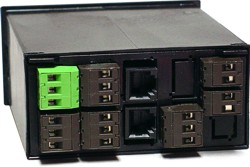
Key Features
- Meets 1/8 DIN Standard.
- Installs from front of panel.
- Short depth behind the panel: only 4" (102 mm) plus connectors.
- Understated 0.157" (4 mm) thick bezel.
- Meets NEMA 4X (IP-65) for high-pressure wawshdon when panel mounted.
- Screw clamps connectors meet VDE / IEC / UL / CSA safety standards.
- Rugged GE Lexan® housing material.
- Safety certified per EN 61010-1.
Dimensions
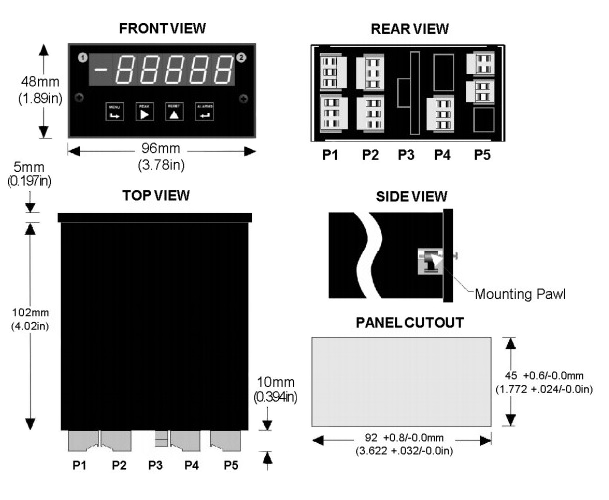
Maximum panel thickness: 4.5 mm (0.18")
Weight of base meter: 210 g (7.4 oz) typical (DPM, counter, timer, 6-digit remote display)
Weight of option boards: 30 g (1.0 oz) typical per board (analog output, relay output, communications)
Tightening Torque - Connectors: Screw terminal connectors: 5 lb-in (0.56 Nm)
Tightening Torque - Pawls: Digital Panel Meter Case Pawls: 5 lb-in (0.56 Nm)
Dimensioned CAD assembly drawings in EPRT, STEP, x_t. dwg, pdf file formats: Laureate-meter-case.zip (zipping prevents browser from opening CAD files as text files).
Panel Mounting
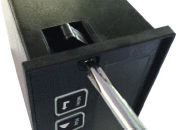 Slide the meter into a 45 x 92 mm 1/8 DIN panel cutout. Ensure that the provided gasket is in place between the front of the panel and the back of the meter bezel.
The meter is secured by two pawls, each held by a screw, as illustrated. Turning each screw counterclockwise extends the pawl outward from the case and behind the panel. Turning each screw clockwise further tightens it against the panel to secure the meter.
Slide the meter into a 45 x 92 mm 1/8 DIN panel cutout. Ensure that the provided gasket is in place between the front of the panel and the back of the meter bezel.
The meter is secured by two pawls, each held by a screw, as illustrated. Turning each screw counterclockwise extends the pawl outward from the case and behind the panel. Turning each screw clockwise further tightens it against the panel to secure the meter.
Turning each screw counterclockwise loosens the pawl and retracts it into its well. This position allows installed meter to be removed from their panel, or new meters to be installed in a panel. Do not remove the screws from their pawls. Doing so would cause the screw and pawl to fall off and likely get lost. Do not overtighten so as not to damage the plastic parts.
| Controlling the Mixing Ratio of Two Fluids | |
|---|---|
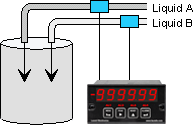 |
Displaying and alarming the input flow rate ratio of two fluids (gas or liquid) allows these to be mixed in a predetermined ratio in continuous processes. The sensing element is normally a turbine flowmeter, which outputs pulses at a frequency proportional to flow rate. The A/B ratio can also be displayed for totalized rate (or delivered volume). |
| Computing Net Fluid Inflow & Outflow | |
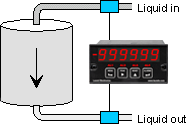 |
The ratio of the inflow and outflow rates of a tank is a measure of the relative filling or emptying rate. The same meter can also be programmed to display the net inflow or outflow rate in flow units, or to display totalized inflow our outflow in volume units. Any of these parameters can be alarmed using the dual relay board and be transmitted via 4-20 mA, RS232 or RS485. |
| Controlling Coating Thickness on a Film | |
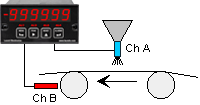 |
In this application, Channel A measures the rate at which a coating material is applied, as measured by a flow meter, while Channel B measures the speed of the film based on pulses from a proximity switch. Displaying and alarming the A/B ratio assures that an even thickness of coating material is applied as the speed of the film is varies. |
| Synchronizing Two Conveyor Lines | |
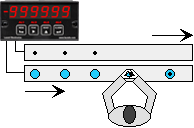 |
The dual-channel Laureate counter can measure the speed of conveyor lines by using the output of proximity switches which sense gear teeth or spokes of rotating drive wheels. Displaying the speed ratio of two lines allows line speeds to be adjusted so that material arrives at work stations when needed. |
| Measuring Draw for Elongation | |
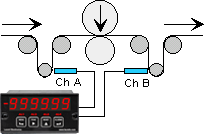 |
Draw (Ch A / Ch B - 1) can be used to display the elongation of films compressed between rollers, the shrinkage films, and the RPM difference of rollers whose speed is varied to maintain tension. The six-digit resolution of the Laureate dual channel counter / rate meter is ideal for comparison of rates that are close to each other. |
IPC
Splashproof Cover
CLB01
RS232 Cable for Meters
CLB02
USB-to-RS232 Adapter Cable
CBL04
RS232 Cable for LT Transmitters
CLB05
USB Data Cable for Meters
CLB06
USB-to-RS485 Adapter Cable
CLB07
USB Programming & Data Cable
CLB08
RS485 Splitter Cable
BKBD
RS485 RJ11 Terminal Block Adapter
What is a 1/8 DIN Digital Panel Meter for Rate, Totalizer, and Mathematical Functions (A+B, A-B, A×B, A/B, A/B-1)?
In the world of industrial automation, measurement, and control, precision and reliability are paramount. Among the many tools that professionals rely on, the 1/8 DIN Digital Panel Meter is a crucial component, particularly when it comes to measuring rates, totals, and performing various mathematical functions. But what exactly is a 1/8 DIN Digital Panel Meter, and how does it serve these specific purposes?
Understanding 1/8 DIN Digital Panel Meters
A 1/8 DIN Digital Panel Meter is an electronic instrument used for displaying measurements in a digital format. The term "1/8 DIN" refers to the size of the panel meter, where "DIN" stands for "Deutsches Institut für Normung," a German standards organization. The "1/8" designation indicates that the panel meter occupies one-eighth of a standard DIN enclosure, making it a compact yet versatile option for various applications.
Applications of 1/8 DIN Digital Panel Meters
These panel meters are commonly used in industrial settings to monitor and display a wide range of parameters, such as voltage, current, temperature, pressure, and more. However, when it comes to measuring rate and totalizer functions, as well as performing specific mathematical operations, the 1/8 DIN Digital Panel Meter becomes an even more powerful tool.
Rate Measurement
In industrial processes, rate measurement is crucial for monitoring the speed at which something occurs, such as the flow rate of a liquid or the speed of a conveyor belt. A 1/8 DIN Digital Panel Meter designed for rate measurement can accurately display the rate at which an event is occurring in real-time, providing operators with critical data to ensure that processes are running smoothly and efficiently.
Totalizer Function
The totalizer function of a 1/8 DIN Digital Panel Meter allows it to accumulate a total value over time. For example, in a production line, the totalizer can keep track of the total number of items produced or the total volume of a liquid that has flowed through a system. This function is essential for keeping records, generating reports, and ensuring that production targets are met.
Mathematical Functions: A+B, A-B, A×B, A/B, A/B-1
One of the standout features of advanced 1/8 DIN Digital Panel Meters is their ability to perform mathematical operations on the inputs they receive. These operations include:
-
A+B: The meter can sum two input values, providing a total that may represent the combined flow of two separate sources, for example.
-
A-B: This function allows the meter to calculate the difference between two input values, which could be used to monitor the net flow rate between an input and output.
-
A×B: The meter can multiply two input values together, which might be used to calculate the power consumption by multiplying current and voltage.
-
A/B: Division of two input values is possible, which can be useful for determining ratios, such as the ratio of two different flow rates.
-
A/B-1: This more complex function allows the meter to calculate a percentage difference or deviation between two input values, providing insights into variations in process conditions.
Conclusion
A 1/8 DIN Digital Panel Meter is more than just a display device; it is a sophisticated tool designed to provide precise and real-time data critical for industrial automation and control. Whether used for rate measurement, totalizing functions, or performing complex mathematical operations, these meters are indispensable in ensuring efficient, accurate, and reliable process management. Their compact size, versatility, and advanced capabilities make them a preferred choice in a wide range of industrial applications.
Where is a 1/8 DIN Digital Panel Meter for Rate, Totalizer, Functions A+B, A-B, AxB, A/B, A/B-1 Used?
Digital panel meters (DPMs) have become essential tools in modern industrial and process control environments. Among the various types available, the 1/8 DIN digital panel meter stands out for its compact size, versatility, and ability to perform complex functions such as rate measurement, totalizing, and mathematical operations like A+B, A-B, AxB, A/B, and A/B-1. But where exactly are these devices used? This article explores the various applications of 1/8 DIN digital panel meters in different industries.
1. Manufacturing and Process Control
In manufacturing plants, accurate measurement and control of various parameters like flow rate, temperature, pressure, and volume are crucial. A 1/8 DIN digital panel meter can be integrated into control panels to monitor these parameters. The device's ability to perform functions such as totalizing (adding up flow rates over time) and rate calculation (measuring flow or production speed) makes it invaluable for ensuring consistent product quality and process efficiency.
For instance, in a chemical processing plant, the digital panel meter can be used to measure and display the flow rate of different chemicals into a reactor. The A+B function can sum the flow rates from multiple sources, while the A-B function can calculate the difference between input and output flows, helping to detect leaks or inefficiencies.
2. Water and Wastewater Treatment
Water and wastewater treatment facilities rely heavily on precise measurements for flow, pH, and chemical dosing. A 1/8 DIN digital panel meter is often used in these facilities to monitor and control the flow rate of water through various stages of treatment. The totalizer function helps operators track the total volume of water processed over time, which is crucial for regulatory reporting and system performance analysis.
In these settings, the ability to perform mathematical operations is also beneficial. For example, the AxB function can be used to multiply the flow rate by a correction factor, which might be necessary when adjusting for sensor calibration errors or environmental conditions.
3. Energy Management Systems
In energy management, particularly in monitoring and optimizing the performance of HVAC systems, power generation, and distribution networks, the 1/8 DIN digital panel meter plays a significant role. It can measure parameters like voltage, current, and power consumption in real time. By using the A/B function, the meter can calculate efficiency ratios, such as energy produced versus energy consumed, helping to identify areas for improvement and cost savings.
Totalizing the energy used over a period is essential for billing and energy audits, while the A/B-1 function can be used to calculate percentage deviations or losses in energy conversion processes.
4. Automotive and Aerospace Testing
In automotive and aerospace industries, testing and quality control are rigorous and demand high precision. 1/8 DIN digital panel meters are often employed in test rigs to monitor various parameters such as pressure, torque, rotational speed, and temperature. The rate and totalizer functions allow engineers to analyze the performance over time, ensuring that the components meet the required standards.
The meter's ability to perform complex mathematical functions enables real-time calculations during tests, such as the power output (using AxB) or efficiency comparisons (using A/B). These capabilities are crucial for optimizing design and ensuring safety in critical applications.
5. Food and Beverage Industry
In the food and beverage industry, maintaining accurate control over ingredients and processes is vital for product quality and consistency. 1/8 DIN digital panel meters are used to monitor and control the flow of ingredients like liquids, gases, and granules. The totalizer function is especially important for batching processes, where precise quantities of ingredients must be measured and recorded.
Moreover, the ability to perform functions like A+B and A/B allows for precise blending and mixing operations. For example, the meter can calculate the ratio of two ingredients being mixed, ensuring the final product meets the desired specifications.
6. Pharmaceutical Manufacturing
Pharmaceutical manufacturing requires precise control over numerous variables to ensure product safety and efficacy. 1/8 DIN digital panel meters are used to monitor flow rates, temperatures, and pressures within the production environment. The totalizer function helps in tracking the cumulative volume of fluids or gases used in a batch, ensuring compliance with stringent regulatory requirements.
In this industry, the meter's mathematical functions are also utilized to adjust and fine-tune processes. For example, the A-B function can be used to monitor the difference in pressure before and after a filter, indicating when maintenance is needed.
Conclusion
A 1/8 DIN digital panel meter is a versatile and powerful tool used across a wide range of industries. Its compact size allows it to be easily integrated into control panels, while its ability to perform complex mathematical functions makes it invaluable for real-time monitoring, control, and analysis. Whether in manufacturing, energy management, or food processing, these meters play a crucial role in ensuring efficiency, safety, and quality. As technology continues to advance, the applications for these devices will only expand, further solidifying their importance in industrial and process control environments.
Less Information.








